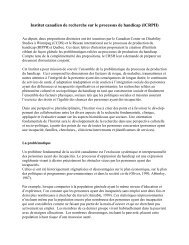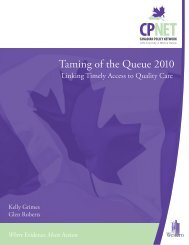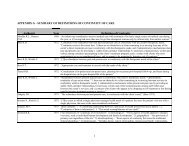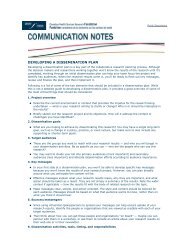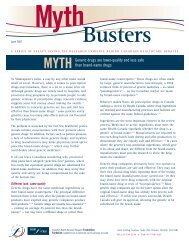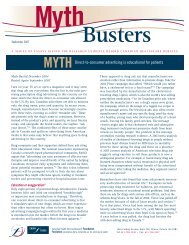Full Report - Fondation canadienne pour l'amélioration des services ...
Full Report - Fondation canadienne pour l'amélioration des services ...
Full Report - Fondation canadienne pour l'amélioration des services ...
You also want an ePaper? Increase the reach of your titles
YUMPU automatically turns print PDFs into web optimized ePapers that Google loves.
key information (test results, consult notes and discharge information) in a manner that is<br />
sufficiently timely and complete to allow for continuity of patient care after hospitalization of<br />
ED care. The few EDs that do contact the PCN with information regarding patient visits usually<br />
do so via mail delivery of hand-written notes. Rubinstein et al. 5 evaluated both emergency and<br />
family physicians’ opinions of such mail-delivered summaries. These reports were actually<br />
carbon copies of the treating emergency department physician’s record and were supposed to<br />
contain data on diagnosis, disposition and pertinent lab tests. The perceived impact of this<br />
system according to the physicians using them (emergency physicians and family physicians)<br />
was decreased speciality referrals by both emergency and family physicians as well as decreased<br />
test ordering and increased visits to hospitalized patients by their family physicians. The family<br />
physicians surveyed in the study however reported significant deficiencies in that same system,<br />
including transmission delays, incomplete and scant content as well as illegibility. Reducing or<br />
eliminating these deficiencies may serve to enhance both the perceived and real benefits.<br />
To achieve high levels of continuity of care and quality of care treating physicians depend on<br />
greater access to information from other health care providers. Three aspects of this<br />
communication must be addressed: 1) the content of the information to be communicated, 2) the<br />
format of the information exchanged and 3) the modality for the communication. Van Walraven<br />
and Rokosh 6 surveyed hospital based physicians-in-training and community family physicians<br />
about the importance of various information elements as they might be included in hospital<br />
discharge summaries. The results indicate a strong consensus between hospital and family<br />
physicians. Elements rated as most important are admitting diagnosis, history of presenting<br />
illness, in-hospital therapeutic procedures, complications during hospital stay, consultations in<br />
hospital, discharge diagnoses, all discharge medication information, arranged medical follow-up,<br />
medical or social issues outstanding at patient discharge, and active medical problems at<br />
discharge. Wass 3 observed that following a patient’s visit to an emergency department, general<br />
practitioners wished to receive details of the results of investigations, diagnosis, treatment plan<br />
and follow-up arrangements. As for important format characteristics influencing the quality and<br />
3, 7,8<br />
use of discharge summaries, studies have concluded that the summary needs to be succinct<br />
and delivered quickly 7 .<br />
2




